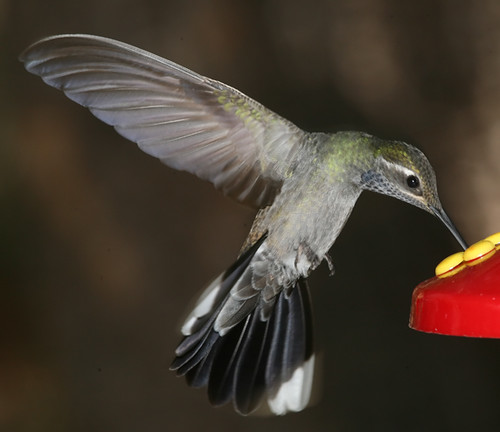tags: Blue-throated hummingbird, Lampornis clemenciae, birds, nature, Image of the Day
My good friend, Dave Rintoul, has just returned from a much-deserved vacation camping in the Chiricahuas and Gila Wilderness area and sent a couple images to share with you.
Juvenile male Blue-throated Hummingbird, Lampornis clemenciae, Cave Creek Canyon, AZ.
Image: Dave Rintoul, June 2008 [larger view].
For comparison, an adult male of the species -- also read the comments section to learn more about how to identify juvenile males of this species.


Another lovely pic from Dave, though actually it's a juvenile male - note the broad pale feather edging for age plus the dull blue of the gorget for sex.
woops! i emailed Dave about this, so he can check this out.
Thanks, Sheri.
I thought that all males would be totally blue-throated by late May/Early June. I guess I was wrong; you've certainly seen a few more of these guys than I have!
cheers
Dave
Last year's males should have full gorgets by now, but this guy is a member of the Class of 2008. Male Blue-throateds start out life with some gorget color (though seldom as much as this one seems to have), as do male Mags. Females with gorget iridescence have been reported in the literature, but having not seen this among the dozens that I've examined at banding stations and in collections makes me wonder if these are cases of mistaken identity.
Sheri
When do these birds start to nest? I guess I expected that all the young of the class of 2008 would be eggs or nestlings in late May!
thanks
They start arriving in March and get down to business pretty quickly. When Tom and I were at Ramsey Canyon Preserve we banded independent youngsters as early as June 3 and big nestlings as early as May 16.
The prominent pale feather edges, especially in the gorget, and overall extremely fresh appearance are my main aging criteria here, but I have to say that the extensive gorget iridescence and inconspicuous white on R3 (if that's not a trick of the light) suggest a more mature bird. One explanation for this apparent conflict would be that this is a second-year male who's recently completed his first prebasic molt (the gorget feathers are the last to come in, and SYs sometimes still have a few "chin-pins" in late May).
Sheri
Yes, the plumage is extremely fresh overall; it was a handsome bird in that regard. I might have some additional pictures of this bird; I can check the archives and see if there are other pics that show the rectrices better, and send those to you (or post them where you can pick them up). Let me know if you are interested.
thanks